Comparative Study and Optimal Design of Subsynchronous Damping Controller in Doubly Fed Induction Generator
Abstract
1. Introduction
2. Comparison of Existing SSDCs
2.1. Mitigation Performance and Robustness
2.2. Application Range of the SSDCs Using One Set of Parameters
2.3. Accessibility of the Input Control Signal
3. Working Mechanism and Improvement of SSDC3
3.1. Working Mechanism of SSDC3
3.2. Influence of SSDC3 Controller Parameters on Mitigation Performance
- (1)
- When SSO is triggered, the negative resistance at the resonance frequency is mainly composed of the RSC current loop proportional gain coefficient kpR3 and rotor resistance rr [22]. When mitigating SSO, the resistance value provided by the SSDC needs to completely offset the negative resistance to keep the system stable. As shown in Figure 7, if the SSO component and rotor resistance in the rotor current reference values idr* and iqr* are ignored, then kp3 should not be less than kpR3.
- (2)
- When kp3 > kpR3, the system provides greater damping to SSO, but also increases the risk of instability caused by the filter. Therefore, keeping the safety and stability of the system under the premise of mitigating SSO, kp3 can be gradually increased from kpR3 until the system stability requirements are met.
- (3)
- The integral coefficient ki3 and the differential coefficient kd3 in SSDC3 are mainly used to adjust the phase of the SSDC3 output signal. If the BPF is designed accurately and there is no phase shift in the extracted oscillation component, then ki3 and kd3 can be designed as 0, that is, the output signal is in the same direction as the rotor current, so that the RSC presents the “virtual resistance” characteristic, thus mitigating SSO.
3.3. Adaptive BPF Design Based on ERA
- (1)
- Adaptive frequency selection based on ERA
- (2)
- Design of damping ζ.
4. Root Locus Analysis and Hardware-in-the-Loop Simulation Experiment
4.1. Root Locus Performance
4.2. Hardware-in-the-Loop Experiment
- (1)
- SSO mitigation performance test
- (2)
- Dynamic performance test—three-phase fault test
5. Conclusions
- (1)
- Three widely accepted SSDCs are compared, and the results show that SSDC3 based on the rotor current feedback performs best regarding mitigation performance, robustness, application range, and accessibility. The verification study indicates that SSDC3 performs well for 100% of working conditions in the simulation, while for SSDC1 and SSDC2, the number is 60% and 94%, respectively.
- (2)
- This paper analyses the influence of the SSDC3 control parameters on its mitigation performance and system stability. The results show that the proportional gain coefficient kp3 plays an essential role in the SSO mitigation performance and system stability. Selecting too large or too small a kp3 can both lead to instability. Therefore, suggestions are provided for the design of the controller parameters.
- (3)
- An adaptive BPF frequency selection method based on the ERA algorithm is proposed, which can accurately track the SSO frequency within 5~45 Hz to make the BPF centre frequency consistent with the oscillation frequency, so as to completely extract the oscillation component and avoid phase compensation.
- (4)
- The performance of the improved SSDC is verified by the root locus analysis and hardware-in-the-loop experiment. The results show that the proposed method has the optimal performance in SSO mitigation and does not affect the normal operation of the DFIG.
Author Contributions
Funding
Institutional Review Board Statement
Informed Consent Statement
Data Availability Statement
Conflicts of Interest
Abbreviations
| SSDC | subsynchronous damping controller |
| SSO | subsynchronous oscillation |
| SupSO | supersynchronous oscillation |
| DFIG | doubly fed induction generator |
| FACTS | flexible AC transmission systems |
| ERCOT | electric reliability council of Texas |
| RMS | root mean square |
| GSC | grid side converter |
| RSC | rotor-side converter |
| ERA | eigensystem realization algorithm |
| BPF | band-pass filter |
| MMAC | multiple-model adaptive control |
| FFT | fast Fourier transform |
| RCP | rapid control prototype |
| Symbols | |
| VC | compensation capacitor voltage |
| ωr | rotor speed |
| idr | d-axis rotor current |
| iqr | q-axis rotor current |
| rr | DFIG rotor resistance |
| xr | DFIG rotor reactance |
| rs | DFIG stator resistance |
| xs | DFIG stator reactance |
| rT | converted resistance of transformers |
| rL | converted resistance of lines |
| xT | converted reactance of transformers |
| xL | converted reactance of lines |
| xm | excitation reactance |
| kpR3 | proportional gain coefficient of RSC |
| Δv | small disturbance in RSC voltage |
| s | slip of asynchronous motor |
| ω | synchronization frequency |
| vdr* | d-axis original RSC voltage |
| vqr* | q-axis original RSC voltage |
| fSSO | subsynchronous frequency |
| kp3 | proportional coefficient of controller |
| ki3 | integral coefficient of controller |
| kd3 | differential coefficient of controller |
| f0 | frequency of the supersynchronous mode |
| fSSO | frequency of the supersynchronous mode |
| Sfilter | state variable of the second-order BPF |
| Δφds | d-axis flux linkage of stator |
| Δφqs | q-axis flux linkage of stator |
| Δφdr | d-axis flux linkage of rotor |
| Δφqr | q-axis flux linkage of rotor |
| fn | centre frequency of BPF |
| ζ | Damping of BPF |
| ωn | Angular frequency corresponding to the BPF center frequency |
Appendix A
| Parameter | Value (SI) | Per-Unit (pu) |
|---|---|---|
| Rated power | 1.5 MW | 0.9 |
| DC-link voltage | 1150 V | |
| Rated voltage | 575 V | 1 |
| Nominal frequency | 60 Hz | 1 |
| Lls, rs | 134 μH, 3.25 mΩ | 0.2552, 0.01638 |
| Llr, rr | 117 μH, 3.62 mΩ | 0.2222, 0.01827 |
| Lm | 8.27 mH | 15.71 |
| Inertial, friction factor, poles | 0.685 0.01 3 | |
| Lline, Rline | 69 mH, 2.26 Ω | |
| Current control (GSC) | Kpig = 0.2, kiig = 5 | |
| DC-link control | Kpdc = 0.4, kidc = 5 | |
| Current control (RSC) | Kpir = 0.6, kiir = 5 | |
| Q control | Kpp = 0.02, kip = 0.08 | |
| Transformer T1(34.5kV) | 31.6 μH, 1.2 mΩ | 0.002, 0.0002 |
| Transformer T2(345kV) | 3.16 mH, 0.12 Ω | 0.002, 0.0002 |
| Parameter | Value | Parameter | Value | Parameter | Value | Parameter | Value |
|---|---|---|---|---|---|---|---|
| Sfilter1 | 0.091 | Sfilter2 | 0.175 | Sfilter3 | 0.088 | Sfilter4 | 0.170 |
| Δφds | 0.0335 | Δφqs | 0.0333 | Δφdr | 0.1388 | Δφqr | 0.1433 |
| ΔVCd | 0.0374 | ΔVCq | 0.0374 | ΔId | 0.0123 | ΔIq | 0.0122 |
| Parameters | Notes | Optimal Choice |
|---|---|---|
| kp3 | Setting kp3 too small will not provide enough damping Setting kp3 too large will cause instability | Increasing from kpR3 until meeting the system stability requirements |
| ζ | ζ = 0.4 is the recommended value | Fixed at 0.4 |
| SSO frequency | Obtained by the adaptive frequency selection | Adaptive frequency selection |
References
- He, Y.; Huang, P. Exploring the Forms of the Economic Effects of Renewable Energy Consumption: Evidence from China. Sustainability 2022, 14, 8212. [Google Scholar] [CrossRef]
- Alasali, F.; Salameh, M.; Semrin, A.; Nusair, K.; El-Naily, N.; Holderbaum, W. Optimal Controllers and Configurations of 100% PV and Energy Storage Systems for a Microgrid: The Case Study of a Small Town in Jordan. Sustainability 2022, 14, 8124. [Google Scholar] [CrossRef]
- Worku, M.Y. Recent Advances in Energy Storage Systems for Renewable Source Grid Integration: A Comprehensive Review. Sustainability 2022, 14, 5985. [Google Scholar] [CrossRef]
- Tummala, A.S. A robust composite wide area control of a DFIG wind energy system for damping inter-area oscillations. Prot. Control. Mod. Power Syst. 2020, 5, 260–269. [Google Scholar] [CrossRef]
- Xie, X.; Dong, Y.; Han, Y. Online estimation of turbine–generator shaft fatigue loss-of-life caused by subsynchronous resonance. Electr. Power Syst. Res. 2012, 192, 171–179. [Google Scholar] [CrossRef]
- Trevisan, A.; Mendonça, A.; Gagnon, R.; Fecteau, M.; Mahseredjian, J. Assessment of interactions involving wind farms in large-scale grids. Electr. Power Syst. Res. 2021, 196, 107220. [Google Scholar] [CrossRef]
- Liu, H.; Xie, X.; He, J.; Xu, T.; Yu, Z.; Wang, C.; Zhang, C. Subsynchronous Interaction Between Direct-Drive PMSG Based Wind Farms and Weak AC Networks. IEEE Trans. Power Syst. 2017, 32, 4708–4720. [Google Scholar] [CrossRef]
- Xu, S.; Wang, Y.; Xiao, X.; Wu, J.; Lv, W. Non-Characteristic Harmonic Resonance in LCC-HVDC Terminals: A Practical Case Study. Int. Trans. Electr. Energy Syst. 2021, 31, e12743. [Google Scholar] [CrossRef]
- Xie, X.; Zhan, Y.; Liu, H.; Li, W.; Wu, C. Wide-area monitoring and early-warning of subsynchronous oscillation in power systems with high-penetration of renewables. Int. J. Electr. Power Energy Syst. 2019, 108, 31–39. [Google Scholar] [CrossRef]
- Shim, K.S.; Kim, S.T.; Lee, J.H.; Choi, E.; Choi, J. Detection of low-frequency oscillation using synchrophasor in wide-area rolling blackouts. Int. J. Electr. Power Energy Syst. 2014, 63, 1015–1022. [Google Scholar] [CrossRef]
- Rauhala, T.; Gole, A.M.; Jarventausta, P. Detection of subsynchronous torsional oscillation frequencies using phasor measurement. IEEE Trans. Power Deliv. 2016, 31, 11–19. [Google Scholar] [CrossRef]
- Wu, X.; Wang, M.; Shahidehpour, M.; Feng, S.; Chen, X. Model-Free Adaptive Control of STATCOM for SSO Mitigation in DFIG-Based Wind Farm. IEEE Trans. Power Syst. 2021, 36, 5282–5293. [Google Scholar] [CrossRef]
- Shair, J.; Xie, X.; Li, Y.; Terzija, V. Hardware-in-the-Loop and Field Validation of a Rotor-Side Subsynchronous Damping Controller for a Series Compensated DFIG System. IEEE Trans. Power Deliv. 2020, 36, 698–709. [Google Scholar] [CrossRef]
- Ali, M.T.; Zhou, D.; Song, Y.; Ghandhari, M.; Harnefors, L.; Blaabjerg, F. Analysis and Mitigation of SSCI in DFIG Systems With Experimental Validation. IEEE Trans. Energy Convers. 2020, 35, 714–723. [Google Scholar] [CrossRef]
- Chowdhury, M.A.; Mahmud, M.A.; Shen, W.; Pota, H.R. Nonlinear Controller Design for Series-Compensated DFIG-Based Wind Farms to Mitigate Subsynchronous Control Interaction. IEEE Trans. Energy Convers. 2017, 32, 707–719. [Google Scholar] [CrossRef]
- Chowdhury, M.A.; Shafiullah, G.M. SSR Mitigation of Series-Compensated DFIG Wind Farms by a Nonlinear Damping Controller Using Partial Feedback Linearization. IEEE Trans. Power Syst. 2018, 33, 2528–2538. [Google Scholar] [CrossRef]
- Wang, Y.; Wu, Q.; Yang, R.; Tao, G.; Liu, Z. H∞ current damping control of DFIG based wind farm for sub-synchronous control interaction mitigation. Int. J. Power Energy Syst. 2018, 98, 509–519. [Google Scholar] [CrossRef]
- Fan, L.; Miao, Z. Mitigating SSR Using DFIG-Based Wind Generation. IEEE Trans. Sustain. Energy 2012, 3, 349–358. [Google Scholar] [CrossRef]
- Yao, J.; Wang, X.; Li, J.; Liu, R.; Zhang, H. Sub-Synchronous Resonance Damping Control for Series-Compensated DFIG-Based Wind Farm With Improved Particle Swarm Optimization Algorithm. IEEE Trans. Energy Convers. 2019, 34, 849–859. [Google Scholar] [CrossRef]
- Li, Y.; Fan, L.; Miao, Z. Replicating Real-World Wind Farm SSR Events. IEEE Trans. Power Deliv. 2020, 35, 339–348. [Google Scholar] [CrossRef]
- Ghaffarzdeh, H.; Mehrizi-Sani, A. Mitigation of Subsynchronous Resonance Induced by a Type III Wind System. IEEE Trans. Sustain. Energy 2020, 11, 1717–1727. [Google Scholar] [CrossRef]
- Wang, L.; Xie, X.; Jiang, Q.; Liu, H.; Liu, H.; Li, Y. Investigation of SSR in Practical DFIG-Based Wind Farms Connected to a Series-Compensated Power System. IEEE Trans. Power Syst. 2015, 30, 2772–2779. [Google Scholar] [CrossRef]
- Salehi, F.; Matsuo, I.B.M.; Lee, W.-J. Detection of Sub-Synchronous Control Interaction (SSCI) Using Modal Identification Analysis and FFT. In Proceedings of the 2018 North American Power Symposium (NAPS), Fargo, ND, USA, 9–11 September 2018; pp. 1–5. [Google Scholar]
- Salehi, F.; Matsuo, I.B.M.; Brahman, A.; Tabrizi, M.A.; Lee, W.-J. Sub-Synchronous Control Interaction Detection: A Real-Time Application. IEEE Trans. Power Deliv. 2020, 35, 106–116. [Google Scholar] [CrossRef]
- Beza, M.; Bongiorno, M. A modifified RLS algorithm for online estimation of low-frequency oscillations in power systems. IEEE Trans. Power Syst. 2016, 31, 1703–1714. [Google Scholar] [CrossRef]
- Gao, B.; Torquato, R.; Xu, W.; Freitas, W. Waveform-Based Method for Fast and Accurate Identification of Subsynchronous Resonance Events. IEEE Trans. Power Syst. 2019, 34, 3626–3636. [Google Scholar] [CrossRef]
- Wang, Y.; Yang, H.; Xie, X.; Yang, X.; Chen, G. Real-Time Subsynchronous Control Interaction Monitoring using Improved Intrinsic Time-Scale Decomposition. J. Mod. Power Syst. Clean Energy 2022. early access. [Google Scholar]
- Yang, W.; Jiang, X.; Xie, X.; Yang, X.; Xiao, X. Identifying Sources of Subsynchronous Resonance Using Wide-Area Phasor Measurements. IEEE Trans. Power Deliv. 2021, 36, 3242–3254. [Google Scholar]
- Yang, X.; Zhang, J.; Xie, X.; Xiao, X.; Gao, B.; Wang, Y. Interpolated DFT-Based Identification of Sub-Synchronous Oscillation Parameters Using Synchrophasor Data. IEEE Trans. Smart Grid 2020, 11, 2662–2675. [Google Scholar] [CrossRef]
- Chen, L.; Zhao, W.; Wang, F.; Wang, Q.; Huang, S. An Interharmonic Phasor and Frequency Estimator for Subsynchronous Oscillation Identification and Monitoring. IEEE Trans. Instrum. Meas. 2019, 68, 1714–1723. [Google Scholar] [CrossRef]

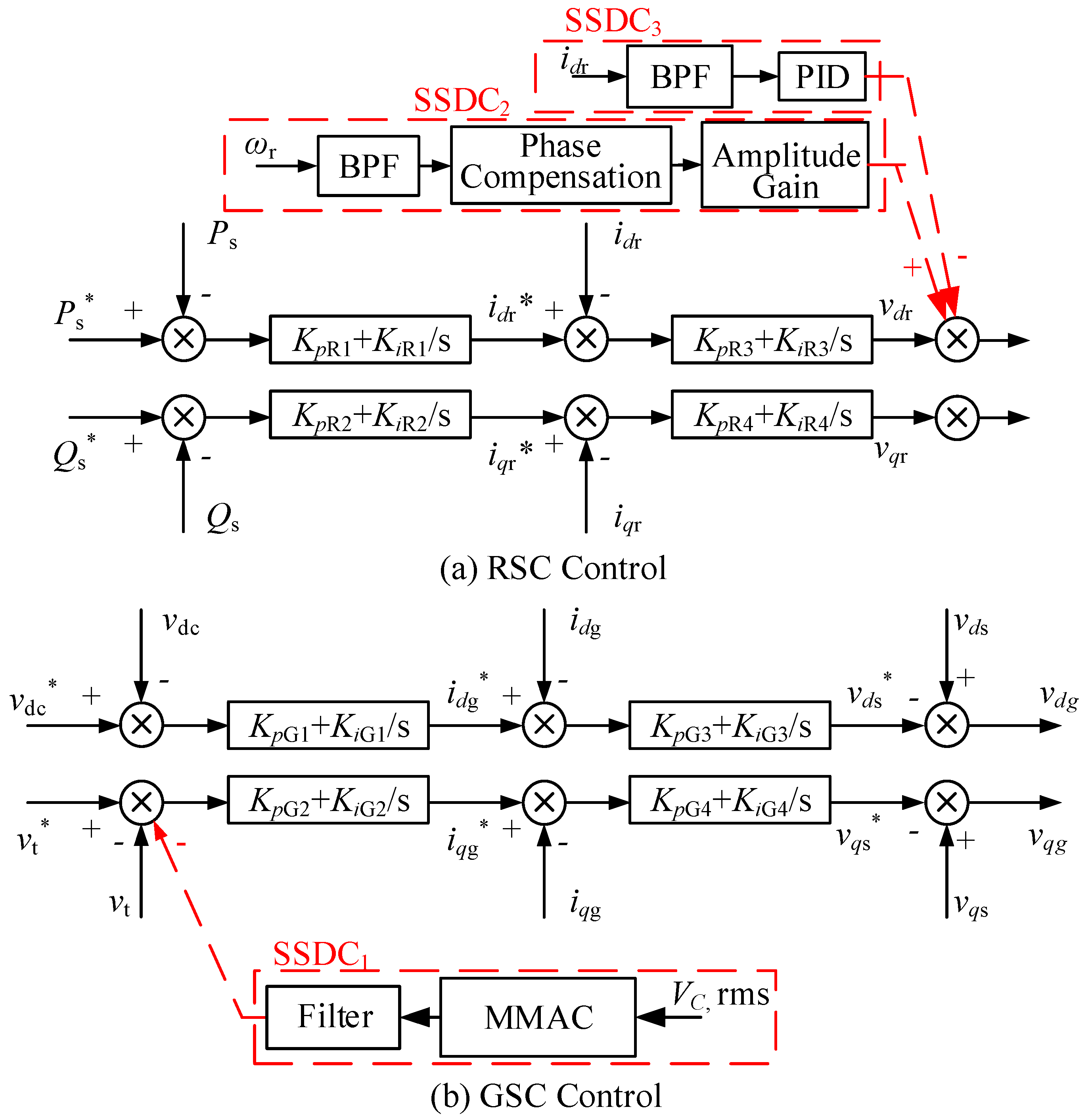
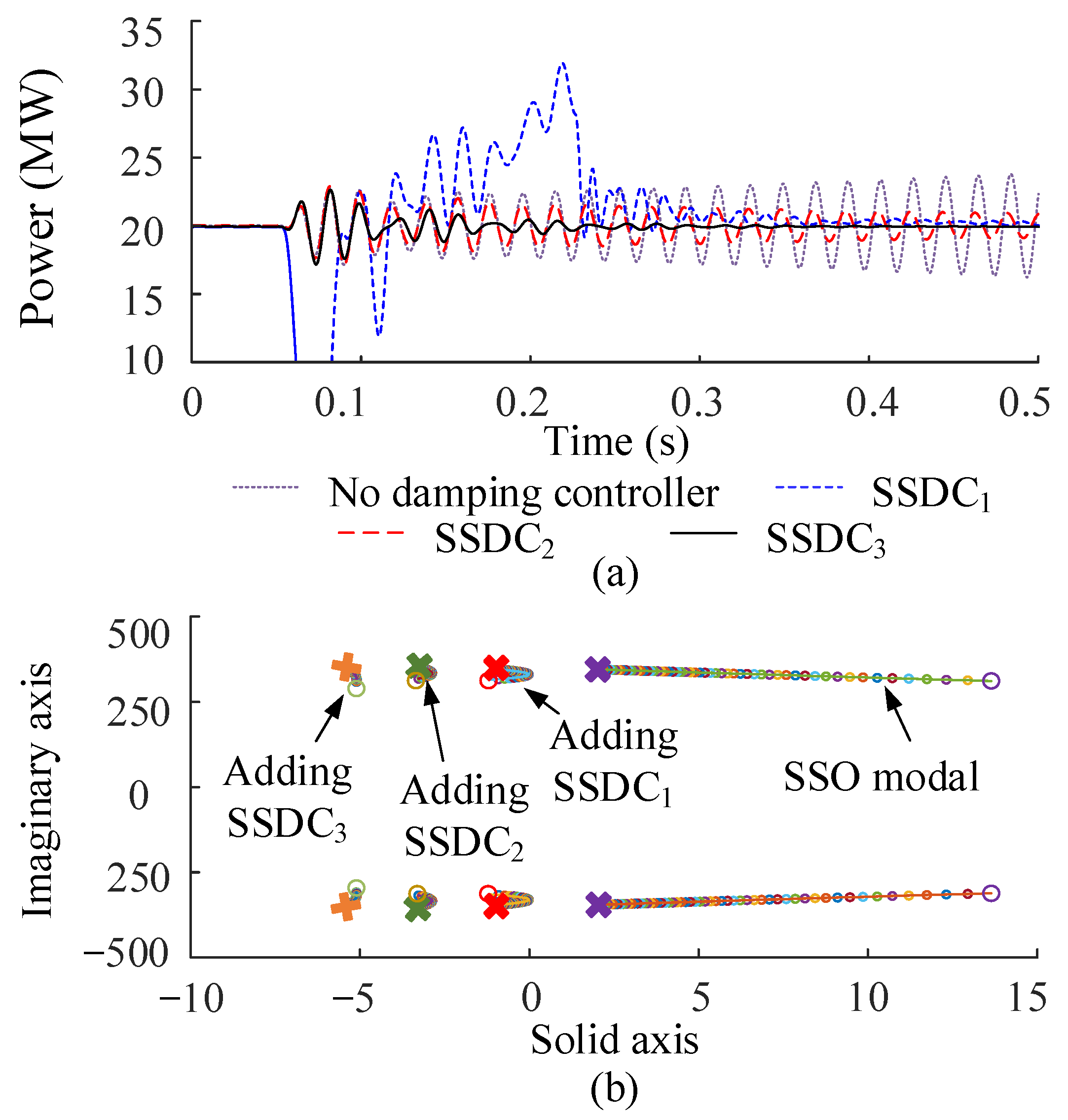
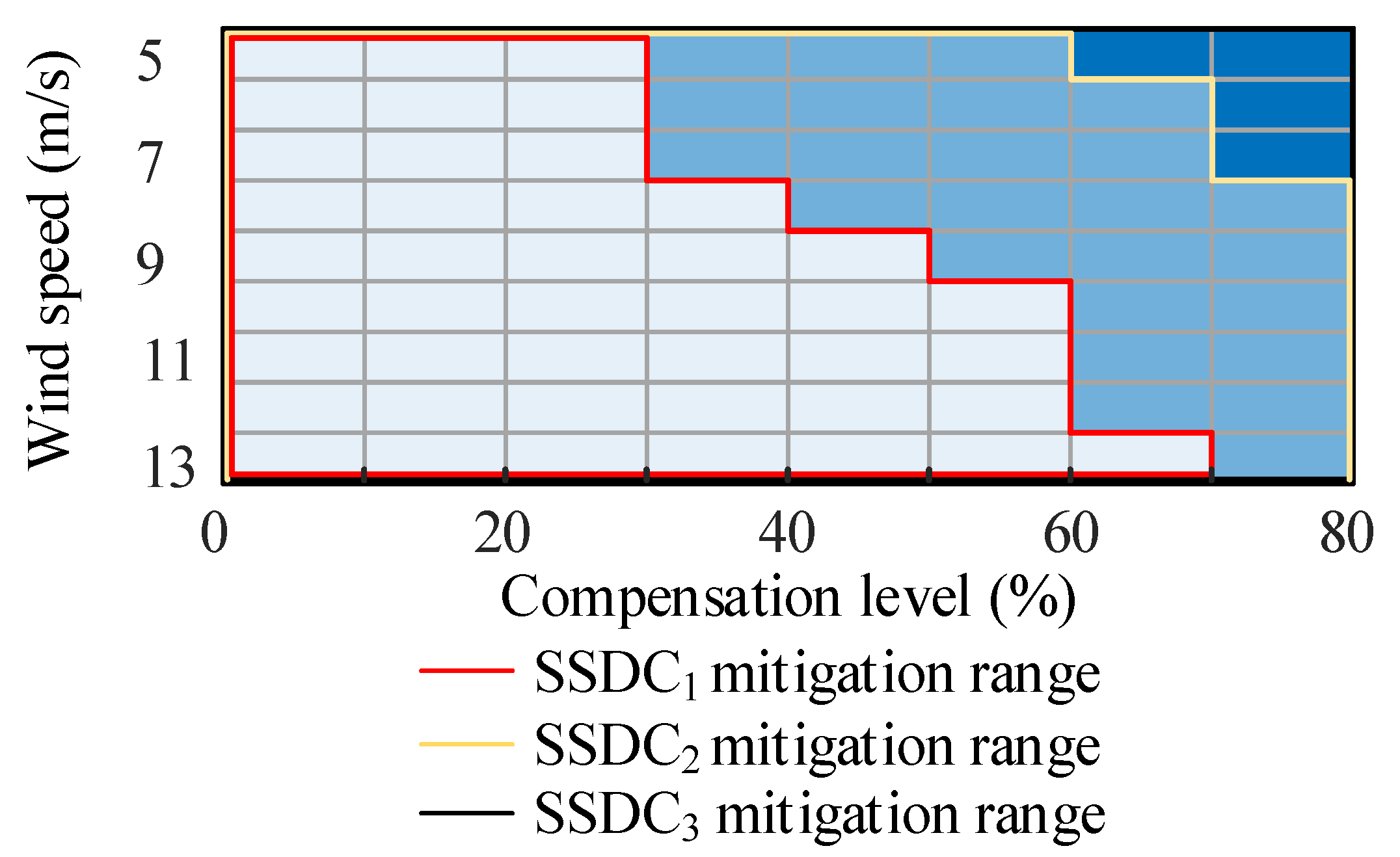

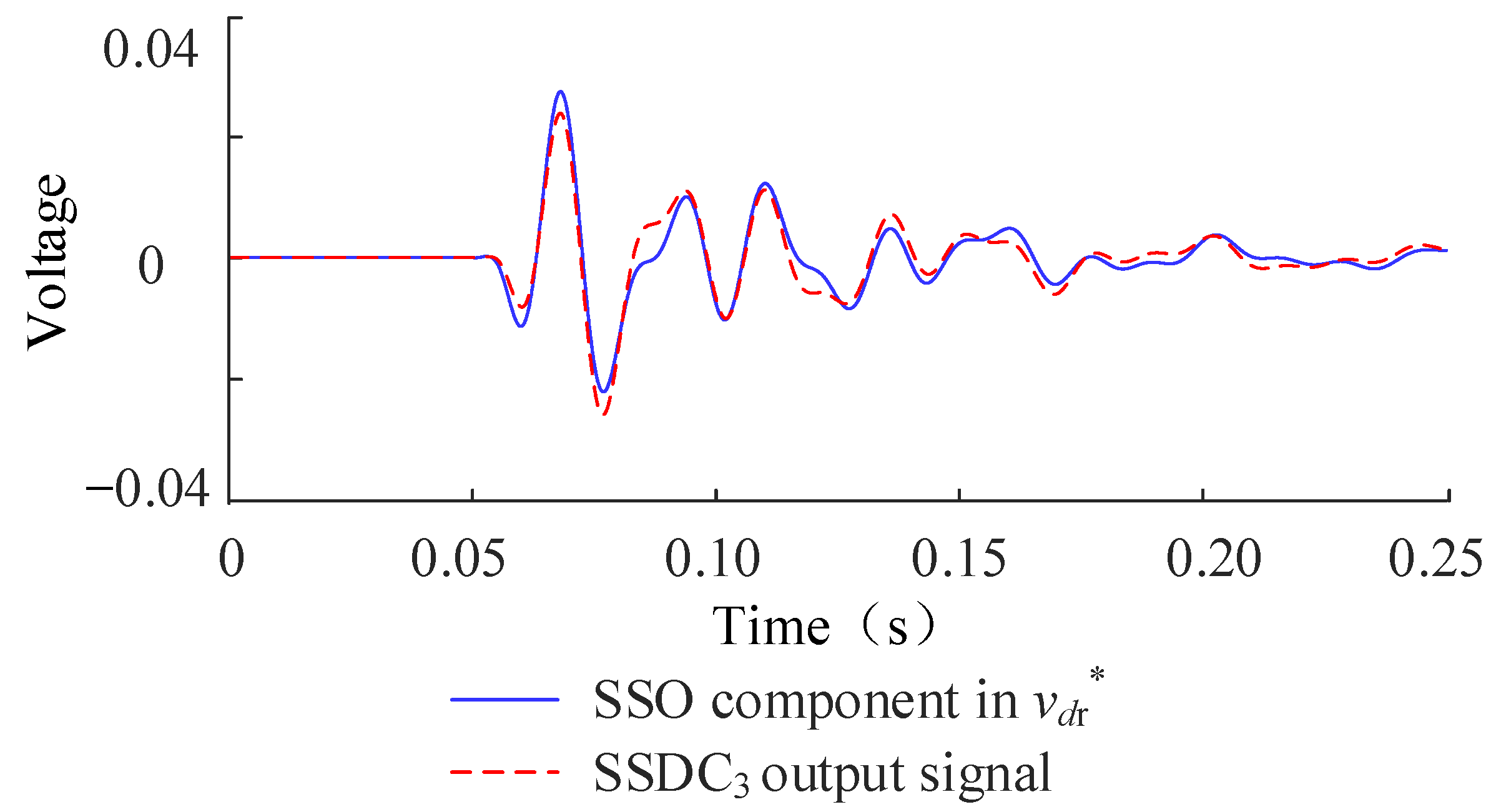

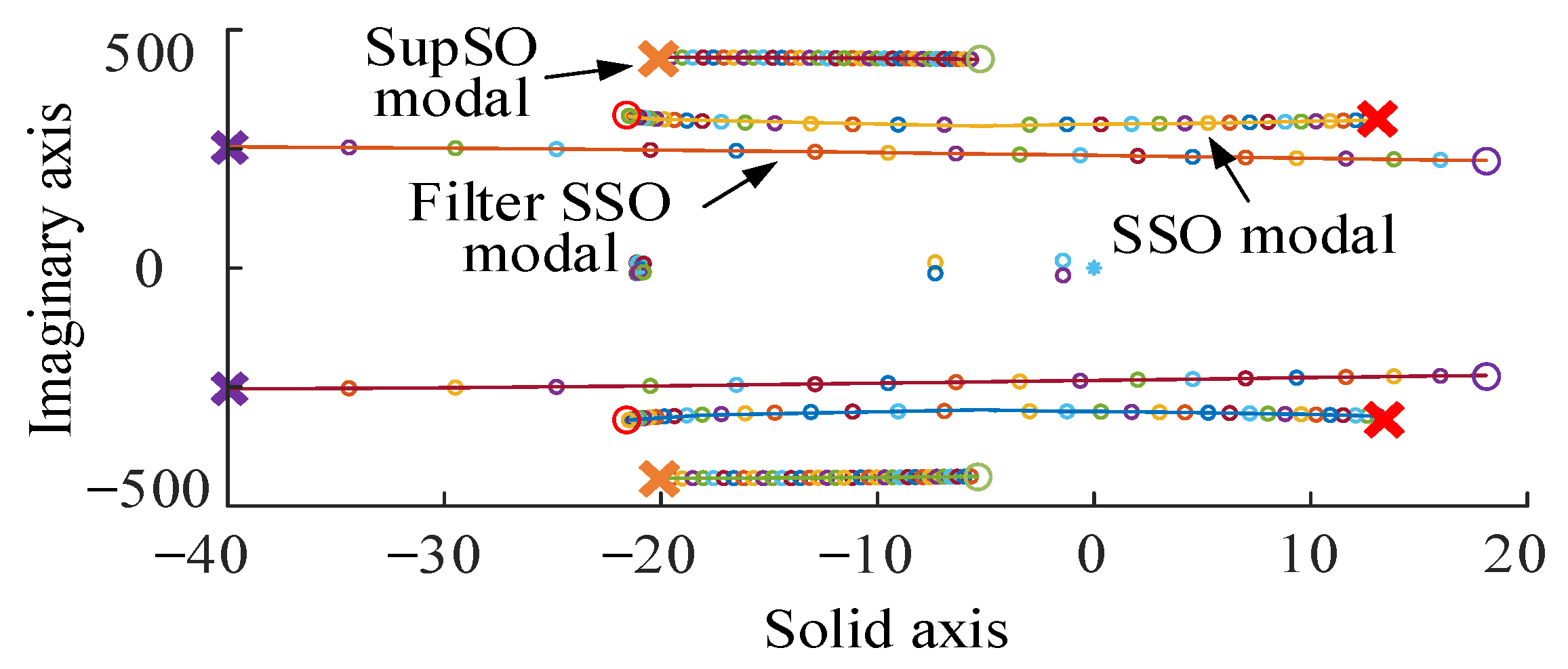
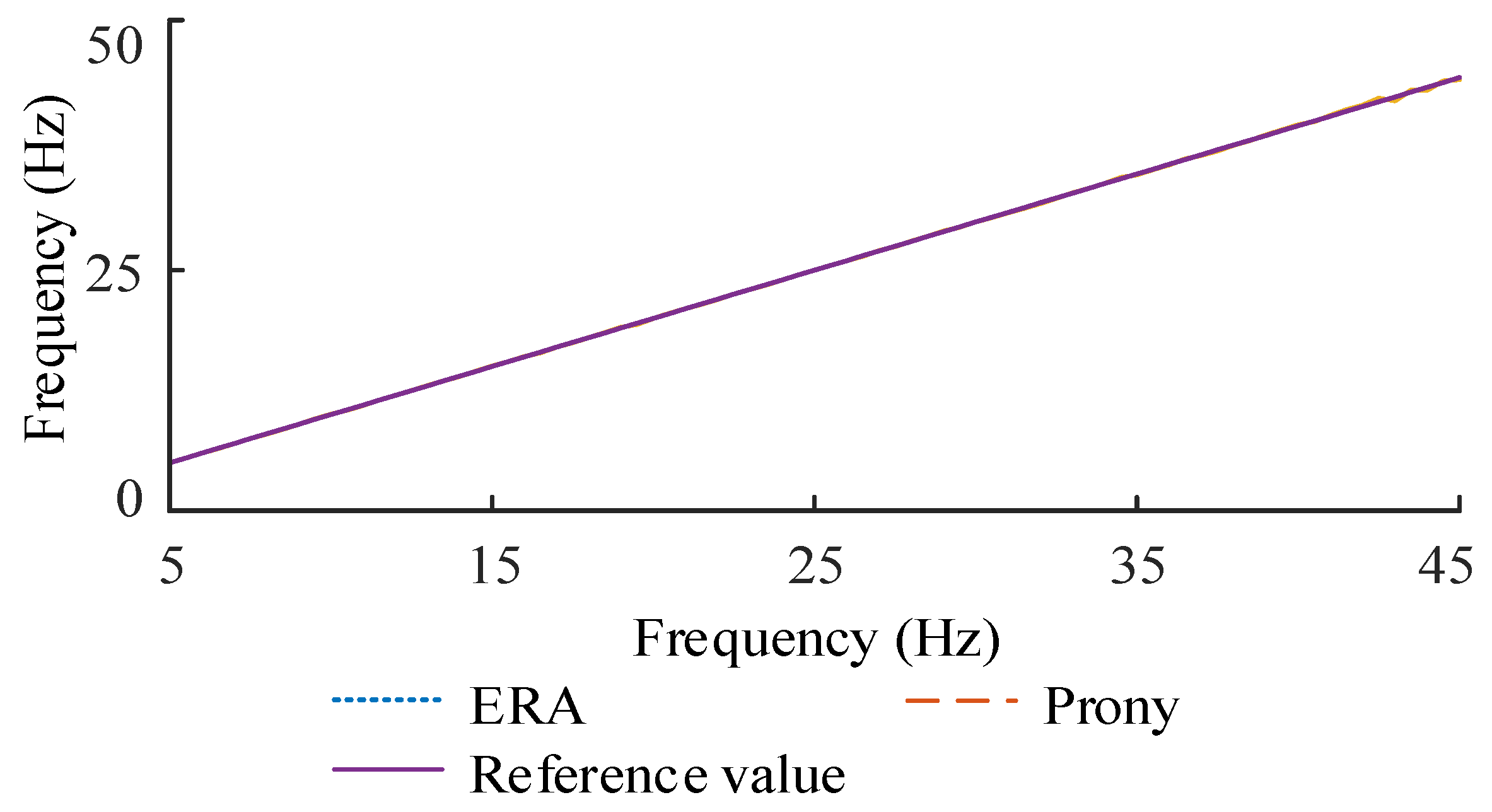
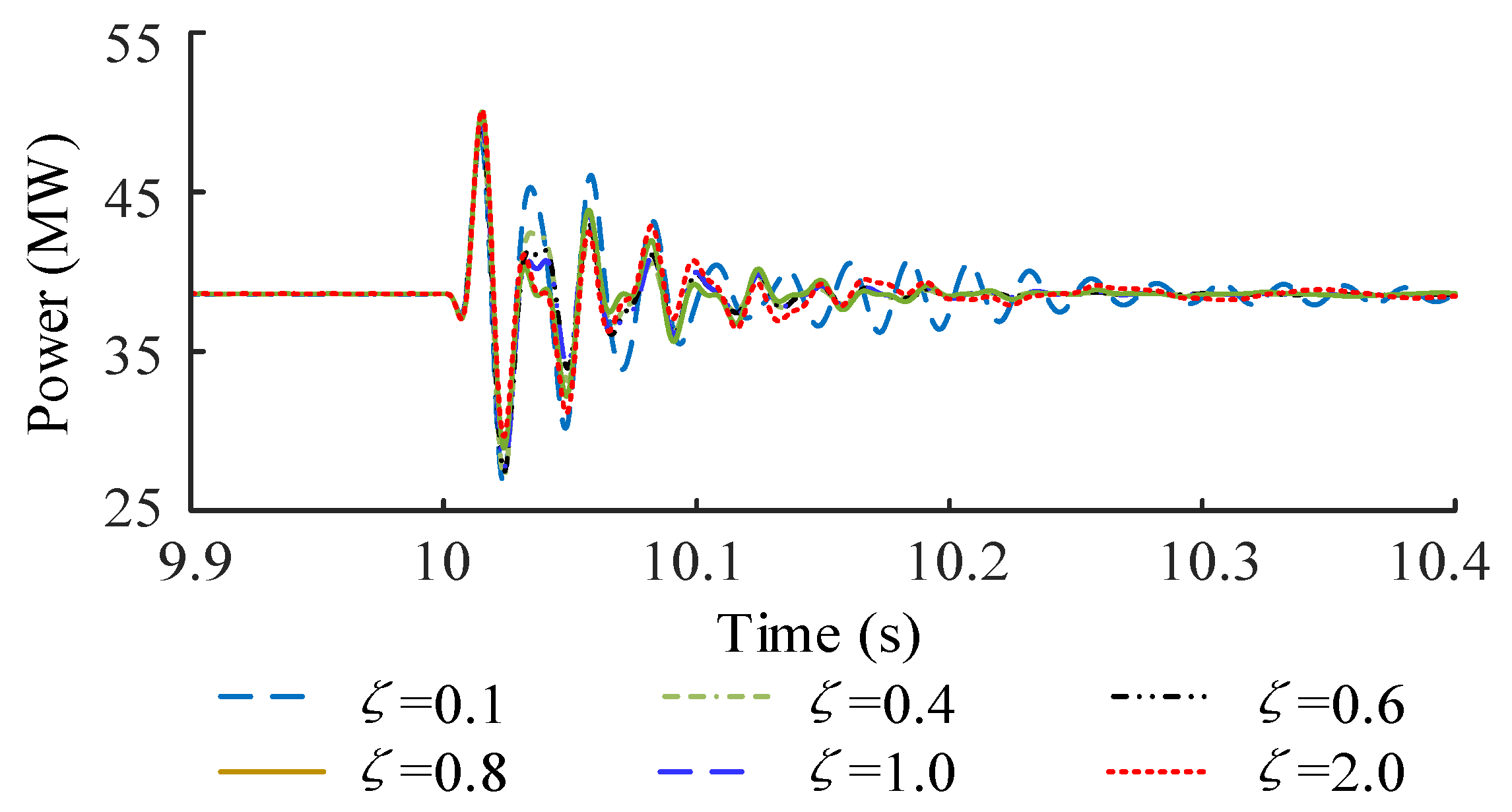

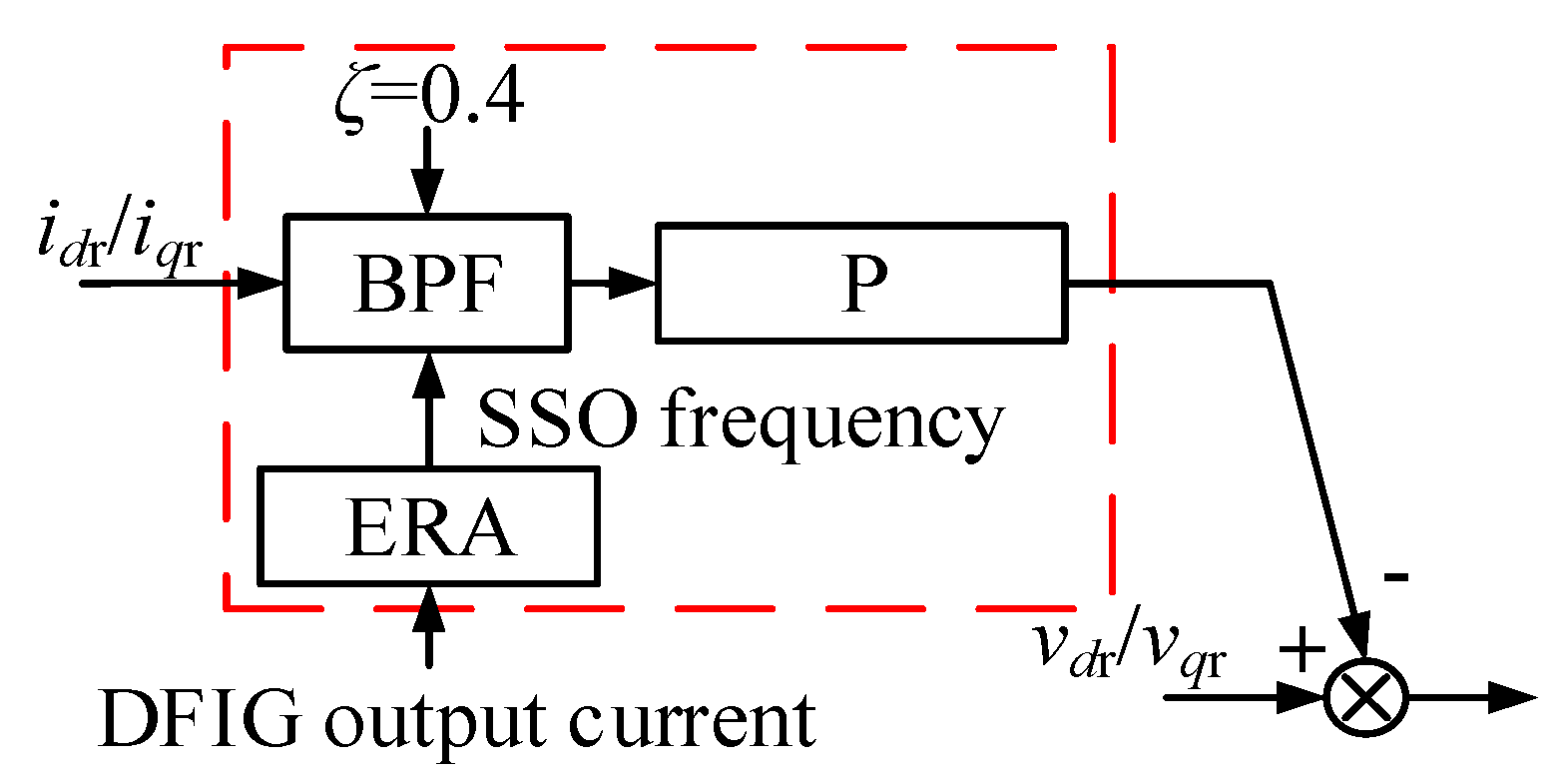
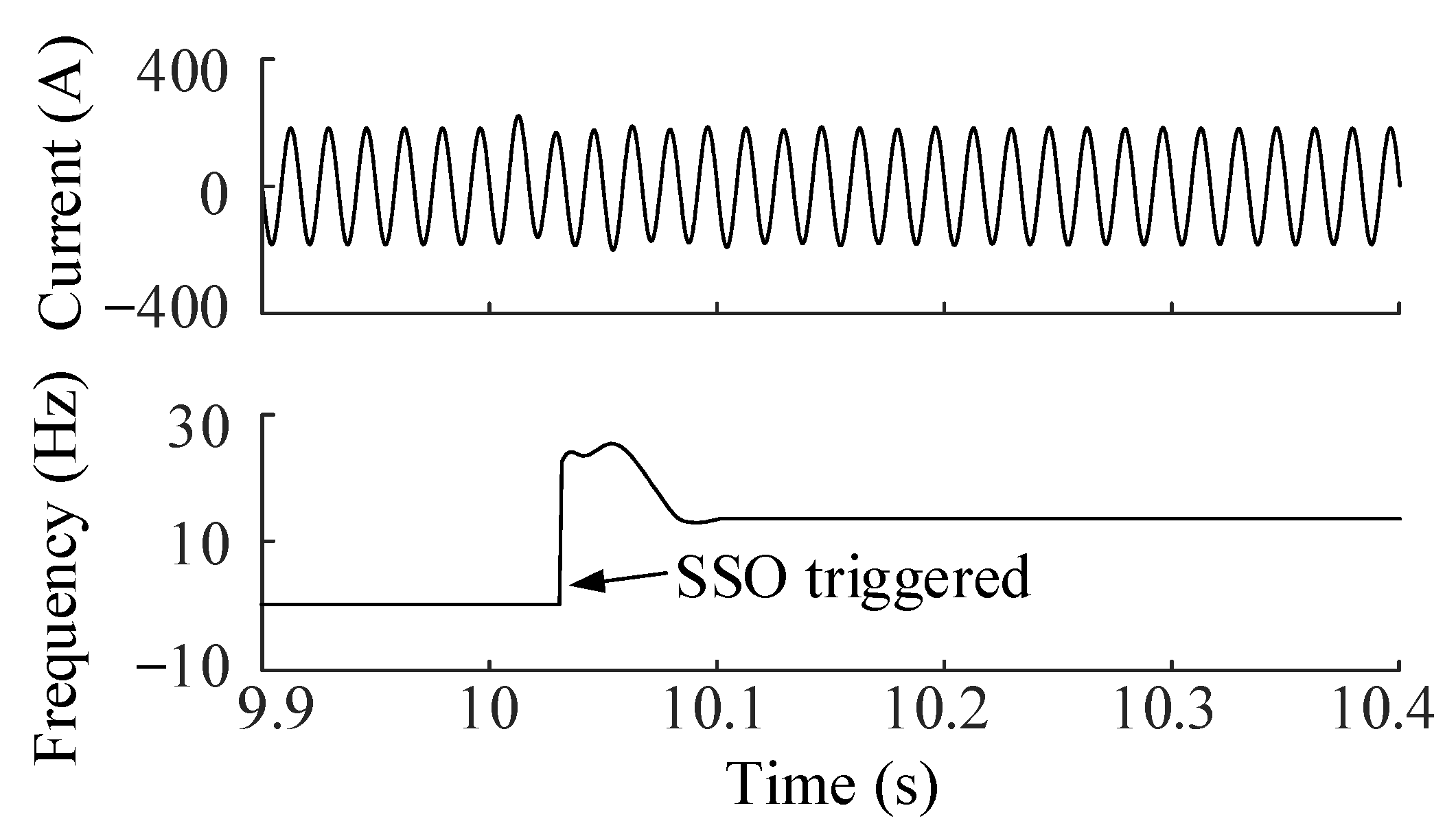
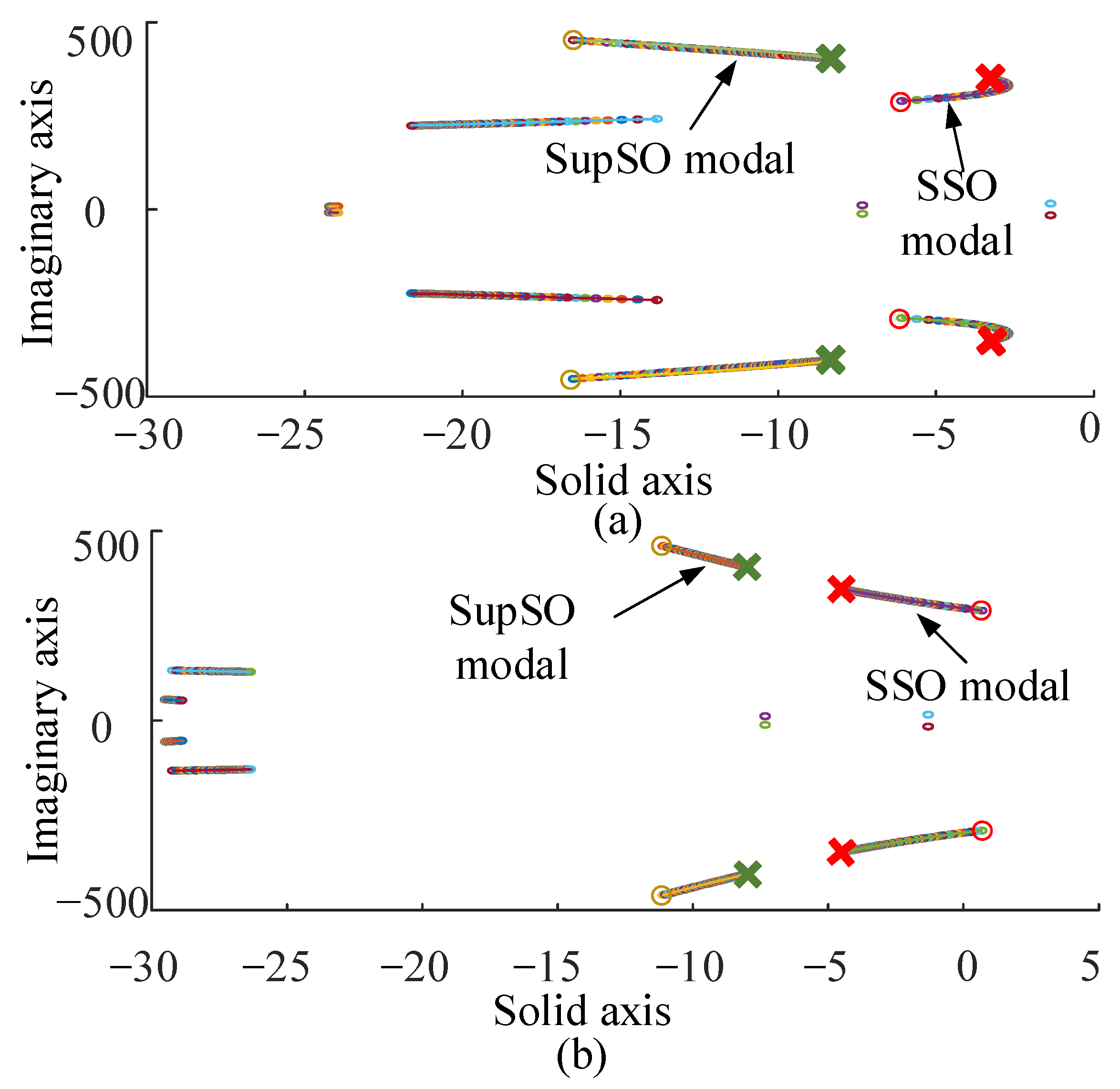
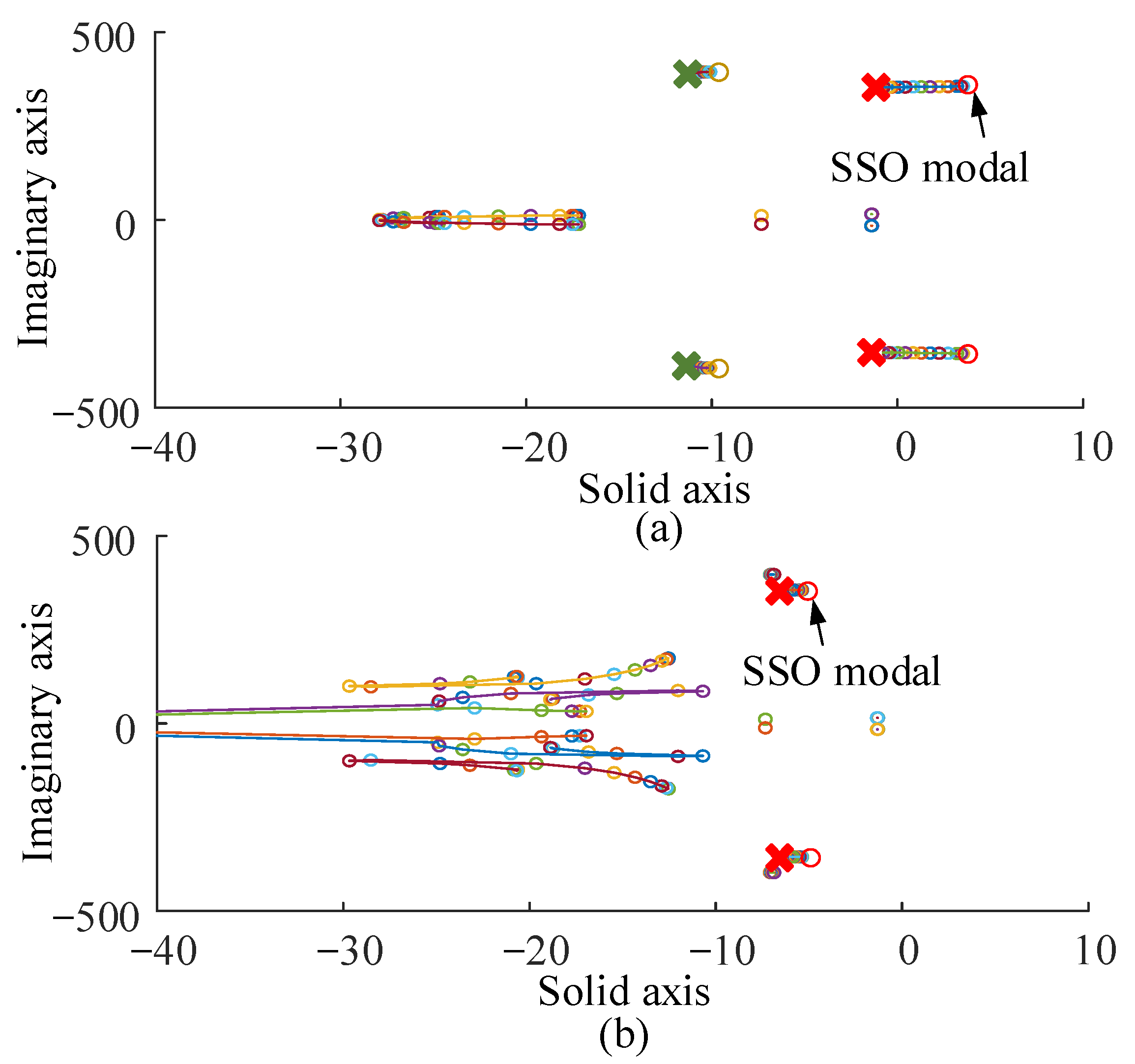
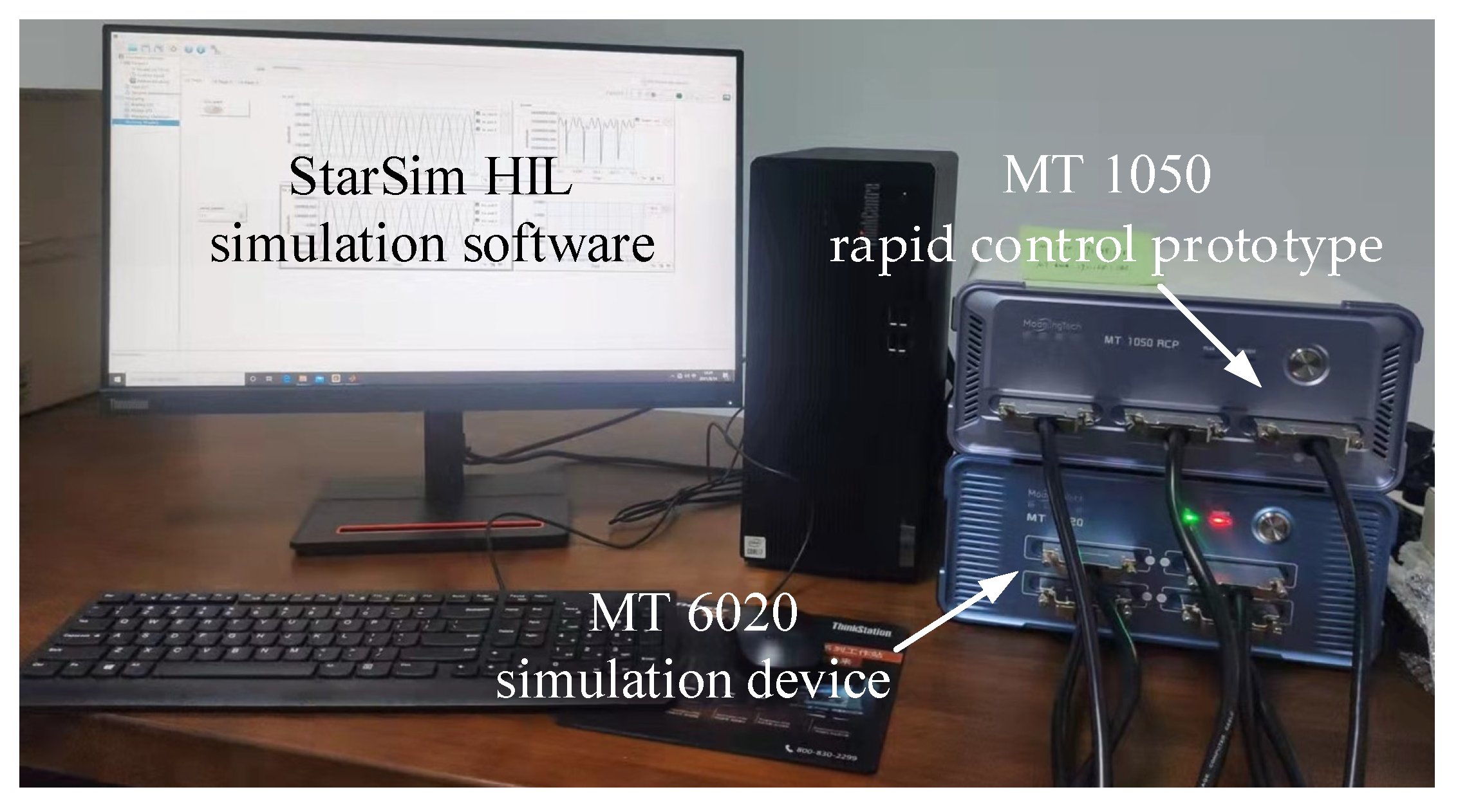

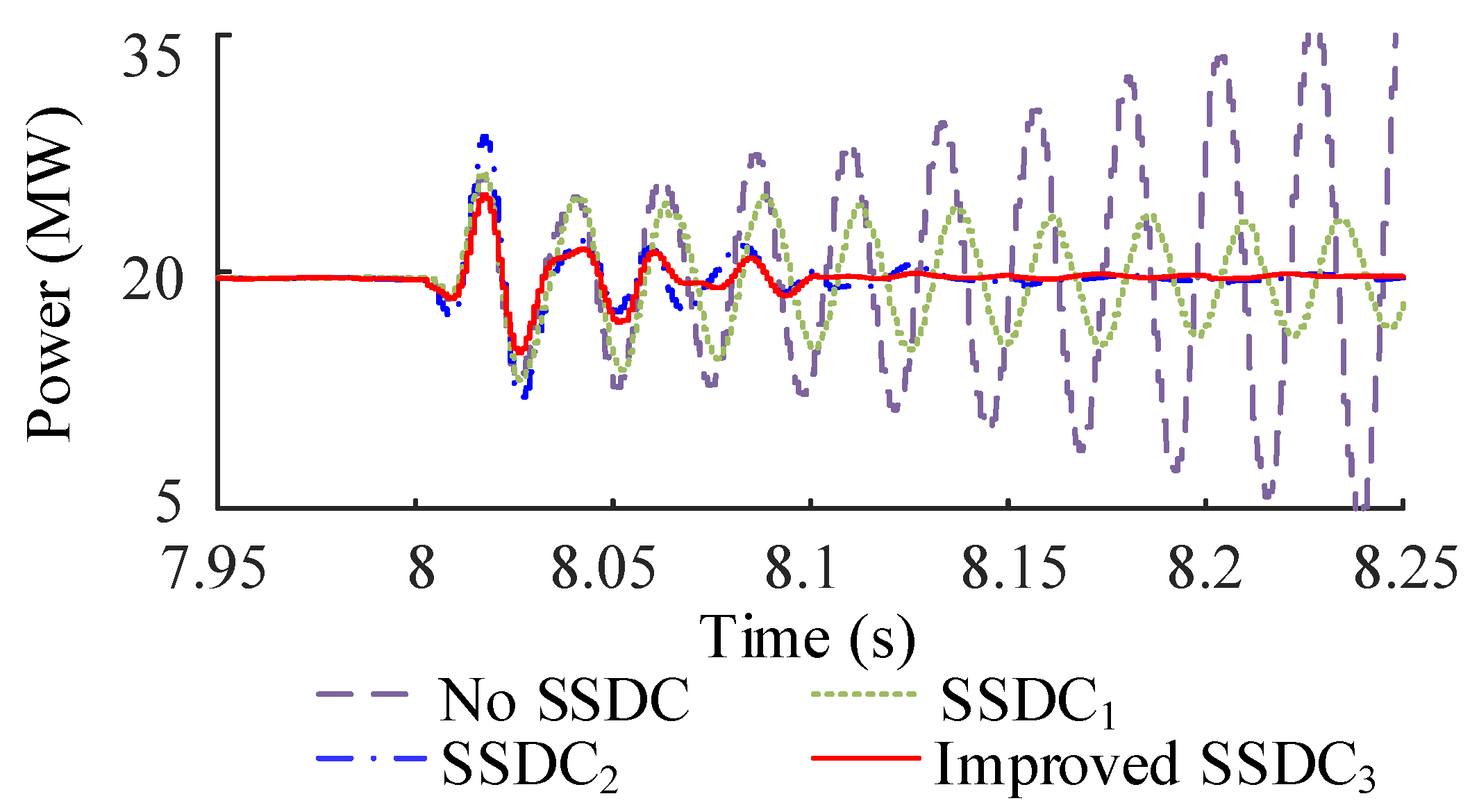

Publisher’s Note: MDPI stays neutral with regard to jurisdictional claims in published maps and institutional affiliations. |
© 2022 by the authors. Licensee MDPI, Basel, Switzerland. This article is an open access article distributed under the terms and conditions of the Creative Commons Attribution (CC BY) license (https://creativecommons.org/licenses/by/4.0/).
Share and Cite
Xiang, S.; Su, P.; Wu, X.; Yang, H.; Wang, C. Comparative Study and Optimal Design of Subsynchronous Damping Controller in Doubly Fed Induction Generator. Sustainability 2022, 14, 13095. https://doi.org/10.3390/su142013095
Xiang S, Su P, Wu X, Yang H, Wang C. Comparative Study and Optimal Design of Subsynchronous Damping Controller in Doubly Fed Induction Generator. Sustainability. 2022; 14(20):13095. https://doi.org/10.3390/su142013095
Chicago/Turabian StyleXiang, Song, Peng Su, Xiaodan Wu, Hanlu Yang, and Chaoqun Wang. 2022. "Comparative Study and Optimal Design of Subsynchronous Damping Controller in Doubly Fed Induction Generator" Sustainability 14, no. 20: 13095. https://doi.org/10.3390/su142013095
APA StyleXiang, S., Su, P., Wu, X., Yang, H., & Wang, C. (2022). Comparative Study and Optimal Design of Subsynchronous Damping Controller in Doubly Fed Induction Generator. Sustainability, 14(20), 13095. https://doi.org/10.3390/su142013095





